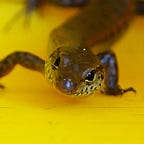A Hundred Snakes and One Salamander
Frans Snyders’ scene-stealing amphibian
Flemish artist Frans Snyders (1579–1657) specialised in painting wildlife. Best known for his elaborate works depicting hares, partridges and other game laid out on crowded tables and for his hunting scenes where dogs chase deer and wild boar, he also collaborated with other artists. Among them was Peter Paul Rubens.
When Rubens painted Prometheus Bound (c. 1612), he sought Snyders to portray the eagle tearing out Prometheus’ liver. When he painted Medusa (c. 1618), Snyders created the snakes.
Medusa. Made a monster by angry Athena. Murdered in her sleep by Perseus, with the help of gods. After death, her body mutilated and her severed head brandished to win squabbles. Then transformed into a talisman, Gorgoneion, worn on Athena’s shield.
The sculptures of Perseus are heroic. The paintings of Medusa are tragic.
Rubens’ Medusa has skin so pale it is almost luminous. In her moment of death, her serpents turn on one another, while new snakes are born from her pooling blood, watery like amniotic fluid.
